

Lake Khecheopari
March 31-April 2, 2003
to Gangtok, he said. He leaped ahead of us and disappeared into a thicket of saplings. Then we heard a few thwacks and out came Pala with a five-foot branch. He trimmed off the twigs with his machete, ran up to me and placed the finished product in my hand. A walking stick. Again he sprang ahead and disappeared, again the thwacks, again he reappeared, this time with a stick several inches longer for Zach.
Before we even had a chance to test them out he vanished down the trail.
--A
The sign told us to please refrain from smoking, drinking, littering, speaking in loud voices, and killing animals, for Lake Khecheopari was a sacred lake that commanded utmost respect. Surrounded by trees, prayer flags, and prayer wheels, this body of water was so special, it was said, that birds prevented even one leaf from falling onto and disturbing its surface. The only encroachment on the water's glass-like sheath this day came from a few renegade raindrops and a fog that slowly began to roll in.
We had the good fortune of being accompanied to the lake by Marianne of Melbourne. She shared with us a recommendation from a friend to seek out Pala, a monk at Khecheopari who provided room and board to backpackers who were keen to climb almost 1000 feet up the hill above the lake. And so we scrambled (slowly, since it had already been a 20-kilometer day) up to a small village perched high in the clouds through which one could just make out spectacular panoramic views of the Himalayan foothills.


We found Pala's "Tea Shop" and then Pala himself, a sprightly 65-year old with a warm smile and quick step. He seemed a little distracted, but was entirely obliging. In addition to the eleven foreigners visiting him that evening (apparently more than usual), several of Pala's nine children, and their children, were visiting from their homes all over Sikkim and West Bengal. It was a summit on the summit, of sorts, with guests from Sydney, Melbourne, Prague, Santiago, Trieste, Copenhagen, Boston, Brooklyn, and the more local Jorethang, Darjeeling, Gangtok, and Kalimpong.
As darkness fell, all eleven of us crammed (for want of warmth and lack of space) into the tea shop, a single room about 10-feet on a side with walls of woven bamboo fortified with mud and a tin roof. We huddled around a low table

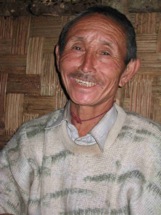
Pala of Khecheopari
covered with four pots: dal, rice, and two vegetable curries. After a long day of trekking the hearty food went down easily and helped to ward off the chill and dampness in the air.
Born and raised in Sikkim, Pala joined the Dalai Lama's army in Tibet when he was in his early 20s. He accompanied the Dalai Lama on his flight from Lhasa to Dharmasala in 1959 and then took up post as his cook for the next 15 years. Our favorite meal of Pala's was a lunch for which he prepared a dish of palak (greens) from his garden, fiddlehead ferns that he collected from the forested areas below the village, and fresh paneer (we watched the cow being milked for the paneer that very morning). The paneer was rich and earthy and the ferns and greens robust and bitter--with a little bit of julienned fresh ginger root it was a delicious combination.
There were more guests than rooms that first night at Pala's, but when one lives in a remote village in the Himalayas with no running water, an unreliable source of electricity, one long drop toilet for a dozen families, and variable weather, one becomes very adaptable and hospitable. So, one of Pala's daughters, along with her

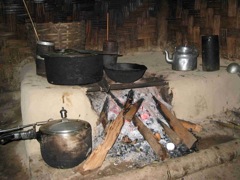
husband and two small children, slept in the kitchen that night, leaving a vacant room (the one adjoining the kitchen) for Zach and me. The heat and smokey smell from the wood-burning fire in the kitchen and quiet conversations in Nepali penetrated through the braided bamboo wall into our room and were deeply comforting. I quickly forgot about my sore, aching muscles and the plywood "mattress" I was resting upon and fell fast asleep.
In the morning we watched as all the school-aged children got ready for their day. The boys threw on their monks' robes and flip flops and went dashing off to the nearby monastery. The girls were busy braiding one another's hair and tied and re-tied big white ribbons into big, round bows until they looked just perfect. Their fresh faces,
bright white blouses, and carefully pressed and pleated skirts were a sharp contrast to the gray rain clouds above their heads and mud below their feet. The children too young for school were left to their own devices. They horsed-around in the tsampa fields, kicked about a flat soccer ball, helped mom with chores, created games out of shreds of old cloth and firewood, and played with grandfather. Most entertaining was a game Pala played with his two-year old

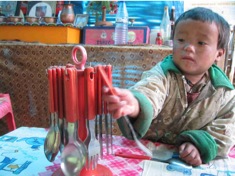
grand-daughter. She would sit in the lotus position, eyes closed, and meditate when Pala cued her--"Buddha meditation," he would say in English. She was not even fazed by our laughter and sat peacefully for longer than most adults could.
After two days at Pala's we decided to leave for Yuksom. The trail back down to the lake was treacherous as there had been a lot of rain. The steep, dirt paths were now slick and precarious. Our packs were heavy, the treads on our boots filled with mud and leaves, and for fear of hurting and muddying myself I set the pace at snail-slow. When we were about halfway down, we heard footsteps above. Bounding out of the forest, down the slick trail at lighting speed with no need for caution came Pala! In his flip flops, no less. He was going down to the lake to catch a jeep
Road Crews: keeping us going
March 26-April 8, 2003
road-laying machinery. We know there will be road work ahead when we start seeing the rock crushers. Exclusively women, there seems to be no limit to the working age. They set up on the narrow shoulders crushing rock into one-inch gravel, those with children keep them close. More than once we had to stop or swerve to avoid a toddler playing in the road. Trekking through the jungle we hear the clack-clack-clack of their hammers for miles.
The handmade gravel is carried in conical baskets (each holds maybe 50 pounds) that hang down the back and are strapped to the foreheads of short men and women. The carriers are almost all short to facilitate the loading by shovel while the basket is
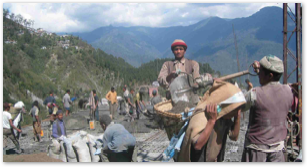

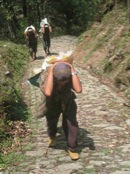
There's no doubt about it, India is vast. While we take to the rails for our long hauls, roads are essential to getting about. This is especially true in the Himalayas where there are just no trains. Building and maintaining the roads is a very manual process, with the Indian government tapping its one limitless resource, human labor. Of the dozens of road crews we encountered only one that had any sort of heavy
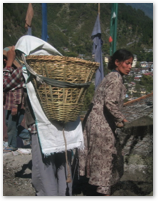
judo-throw over the shoulder. Hot tar and gravel are mixed in oil drums before being laid out by hand on the road bed. Only now does the sole machine on the crew, a small steam roller, get to work.
These crews are everywhere. They seem to be migrant workers since they set up shanty towns next to the seasonal worksites. Children play around the road, running carefree amongst the tar fires and heavy machinery. It is hard to imagine what they think as we drive along the product of their harsh lives.
--Z
hanging on the back. Shoveling is a two-person job, one operates the handle, the other adds extra power by pulling a rope attached just above the blade. After walking the gravel to the tar pots, the carrier empties the basket with a quick
On the second day of the invasion of Iraq, Zach and I found ourselves crammed into the back of a jeep bound for Darjeeling with a young French couple. The Indians sitting in the front and middle seats seemed thrilled by the potential for a Franco-American conflict within the confines of our vehicle but were too cowardly to actively provoke us. They would have been disappointed if they tried. Not only did all of the foreigners in this jeep share similar opinions on the chaos in the Persian Gulf, but we were completely hypnotized by the views out the window and didn't feel much like talking.
We zig-zagged through the mountains past terraced tea plantations, tsampa fields, and banks of clouds. In place of guardrails or reflective lights, safety signs were painted in black and yellow on concrete walls running alongside the mountains.
Jeep Rides: twists and turns
March 26-April 8, 2003
Some read, "Better Late than Dead Never," "Driving is Risky After Whisky," and "Speed is a Knife that Cuts through Life." These morbidly funny signs at almost every turn, the staggering views, not to mention the nonsense conversation about "momos" (Tibetan dumplings) amongst the Indian contingent in the jeep who spoke in English for "our benefit," was enough to nearly bring one to tears. How stunning, frightening, and ridiculous! Such was our experience riding jeeps in the north-east of India.

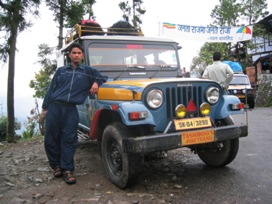

The following safety signs were on the roads between New Jaipulguri, Darjeeling and Gangtok:
Drive Skillfully Live Funfully
If your marraid divoce speed
Enjoy it but not on wheels
Life is short. Don't make it shorter.
It is not rally. Enjoy the valley.
This is highway not runway
Either Drink or Drive
Drive. Don't fly.
Hurry Burry spoils the Curry
Get home in peace not in pieces

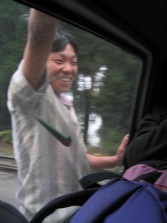
village to buy three packages of biscuits that he and a passenger threw out the windows to the monkeys on the side of the highway; or the silent jeep, filled with passengers transfixed by the gorgeous turquoise-colored river paralleling the road; or the time we were able to hitch onto the Governer of Sikkim's motorcade, giving us priority over bridges and the "green light" through roadworks and other routine traffic stops.
We reached each of our destinations with a sense of awe--the backpacks we stowed on top of the roof were still there, our cramped bodies quickly revived in fresh Himalayan air, and the driver who at first seemed wreckless turned out to just have fast reflexes. Best of all, we were safe and happy to begin explorations in a new valley.
--A
Jeeps in West Bengal and Sikkim comfortably sat nine (including the driver). Eleven passengers were the norm (three up front with the driver and four each in the middle and back), and vehicles didn't max out until sixteen or seventeen. As jeeps were almost the exclusive form of public transportation, everyone used them--villagers from the most remote areas of the Himalayan foothills to savvy Bengali businessmen up on holiday from Calcutta. Each journey had its own character depending on the qualities of these passengers, the driver, and the road. Some rides were raucous, especially when the driver was armed with a Bollywood music cassette, or when a
There’s no more room inside this jeep. Hold on for dear life!
boisterous Hindi conversation was fiercely punctuated by words like IRAQ and BUSH, or roadworks required that two lanes of opposed traffic suffice with just one. And some rides brought smiles and contentment: the driver who stopped in a
Photographs and Text: Copyright 2002 & 2003, Zachary Maler & Amy Leffert